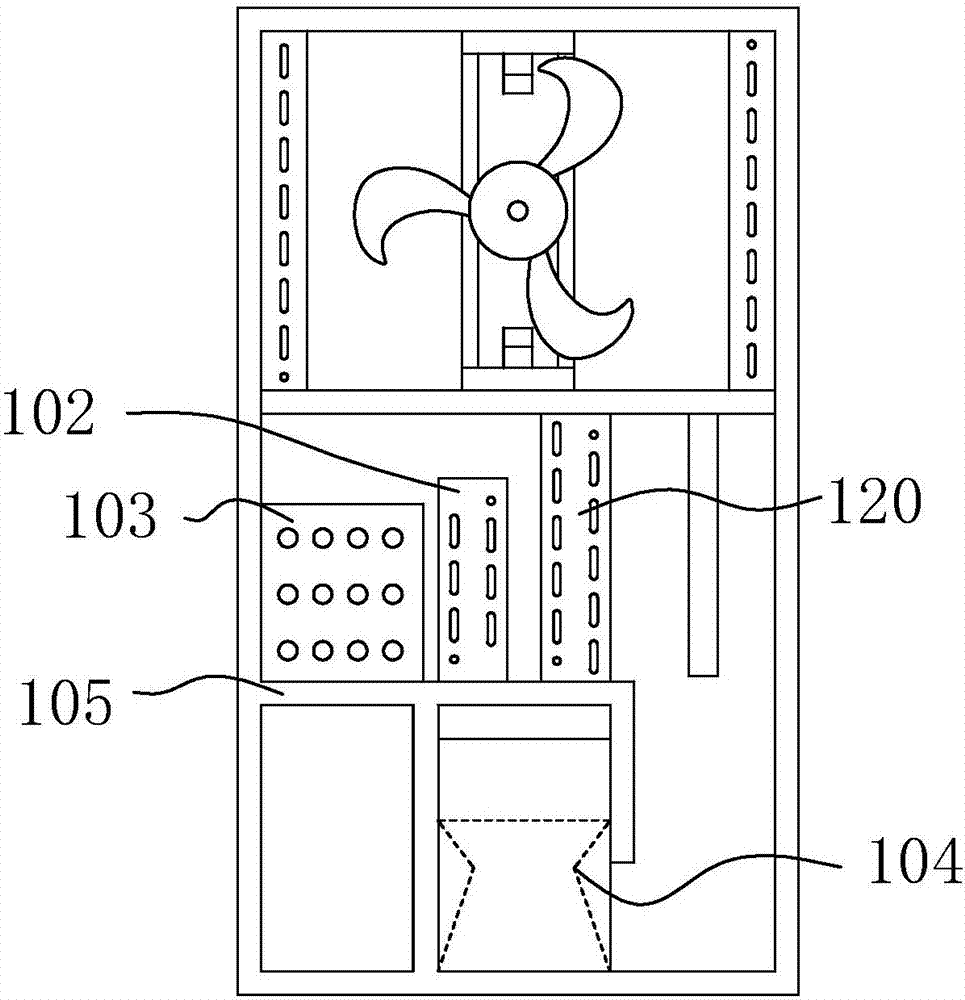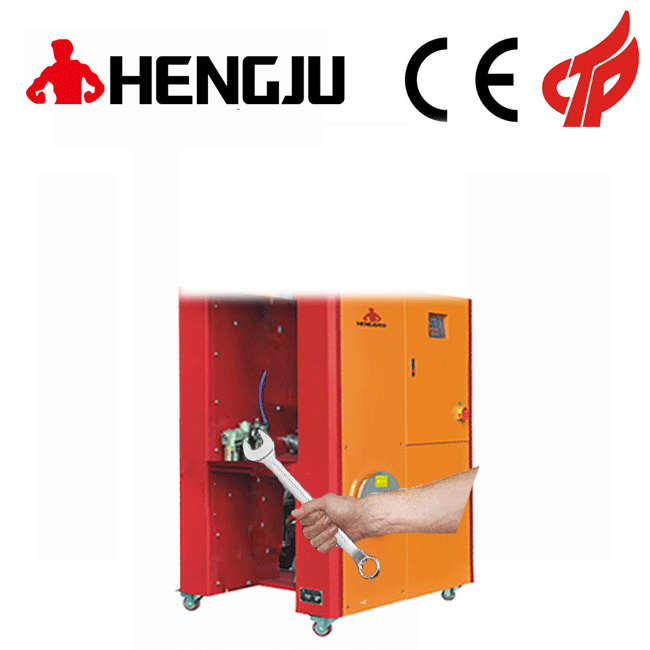Method for manufacturing dehumidification dryer structure
Navigation: Technology>Latest Patent>Heating; Stove; Ventilation; Manufacturing and Application Technology of Drying Equipment
Method for manufacturing dehumidification dryer structure
The utility model relates to a structure of a desiccant dryer.
Background technique:

The structural design of many existing dryers is unreasonable, resulting in low efficiency and high energy consumption. In addition, the moisture in the material will be converted into airflow and discharged into the room, resulting in an increase in indoor humidity. Over time, the wetness on the floor will also cause damage. The dried material is damp again.
Technical realization elements:
The technical problem to be solved by the utility model is to provide a dehumidification dryer structure with high efficiency and no moisture overflow.
The solution of the utility model to solve its technical problems is:
A dehumidification dryer structure includes a body and a vortex fan. The body is provided with a drying chamber, and a processing chamber is provided beside the drying chamber. The processing chamber is provided with a condensation evaporator and the acceleration of the condensation evaporator. It is provided with a moisture inlet which is connected to the drying chamber and the processing chamber. The other side of the condensation evaporator is provided with a processing gas outlet. The processing gas outlet is connected with the inlet of the vortex fan. The outlet of the vortex fan is connected to the drying chamber. The chamber is connected; it also includes a partition plate that separates the inside of the machine body into a processing chamber and a drying chamber. The partition plate is provided with a plurality of through holes, and the processing chamber is provided with a chamber plate to divide the processing chamber It is an upper cavity and a lower cavity. The upper cavity is equipped with the condensation evaporator. The condensation evaporator is located in the middle of the sub-cavity plate. The upper cavity is divided into an air inlet cavity and an air outlet cavity. The moisture inlet is located in the air inlet cavity. Inside, the processing gas outlet is arranged in the air outlet cavity, the vortex fan is arranged in the lower cavity, the heating module is arranged in the air outlet cavity, and the outlet of the vortex fan is arranged in the lower cavity; the heating module includes a heating condenser, heating The condenser is arranged in the gas outlet cavity, the condensation evaporator, the heating condenser, the processing gas outlet is arranged in sequence, and the condensation evaporator is connected with the heating condenser.
As a further improvement of the above technical solution, a partition plate is provided between the processing chamber and the drying chamber, the partition is provided with a plurality of through holes, and the moisture inlet includes the plurality of through holes.
As a further improvement of the above technical solution, the vortex fan is arranged below the condensation evaporator.
As a further improvement of the above technical solution, the upper cavity is provided with an upper segment, which divides the upper cavity into a dehumidification channel and a component placement cavity, a drying cavity, a dehumidification channel, a component placement cavity are arranged in sequence, and a drying cavity It communicates with the dehumidification channel with the through hole, the moisture inlet is provided between the upper part and the lower part and the sub-chamber plate, and the moisture inlet communicates with the element cavity and the dehumidification channel, and the condensation evaporator is arranged at The component is placed in the cavity.
As a further improvement of the above technical solution, the size of the heating condenser is matched with the cross section inside the air outlet cavity, and the air outlet cavity is completely separated by the heating condenser. The size of the condensation evaporator is smaller than the cross section of the upper cavity, thus the condensation evaporator There is a flow gap between the cavity wall and the upper cavity, and the working area of the heating condenser is larger than that of the condensation evaporator.
The beneficial effect of the utility model is: a dehumidification dryer structure, including a body and a vortex fan. The body is equipped with a drying cavity, a processing cavity is arranged beside the drying cavity, and a condensation evaporator is arranged inside the processing cavity. The dew evaporator is equipped with a moisture inlet which communicates with the drying chamber and the processing chamber. The other side of the dew evaporator is provided with a processing gas outlet. The processing gas outlet is connected with the inlet of the vortex fan. The outlet is connected with the drying chamber; it also includes a partition plate, which separates the inside of the machine body into a processing chamber and a drying chamber. The partition is provided with several through holes, and the processing chamber is provided with a chamber plate to connect the processing chamber. It is divided into an upper cavity and a lower cavity. The upper cavity is equipped with the condensation evaporator. The condensation evaporator is arranged in the middle of the sub-cavity plate. The upper cavity is divided into an air inlet cavity and an air outlet cavity. The moisture inlet is arranged at the inlet In the air cavity, the processing gas outlet is arranged in the air outlet cavity, the vortex fan is arranged in the lower cavity, the heating module is arranged in the air outlet cavity, and the outlet of the vortex fan is arranged in the lower cavity; the heating module includes a heating condenser , The heating condenser is arranged in the gas outlet cavity, the condensation evaporator, the heating condenser, and the processing gas outlet are arranged in sequence, and the condensation evaporator is connected with the heating condenser. The air circulates inside the drying chamber and the processing chamber, and when the air passes through the condensation evaporator, it is used for condensation. The moisture in the air will condense into water droplets on the condensation evaporator to realize the function of dehumidification. The utility model is used in a dryer.
Description of the drawings
In order to explain the technical solutions in the embodiments of the present utility model more clearly, the following will briefly describe the drawings needed in the description of the embodiments. It seems that the drawings described are only a part of the embodiments of the present utility model, rather than all the embodiments. Those skilled in the art can also obtain other design schemes and designs based on these drawings without the instruction of the best work. Attached.
Figure 1 is a schematic diagram of the front view of an embodiment of the utility model;
Fig. 2 is a schematic diagram of the right structure of an embodiment of the present invention.
detailed description
In the following, the idea, specific structure and technical effects of the utility model will be clearly and completely described in conjunction with the embodiments and drawings, so as to fully understand the purpose, features and effects of the utility model. Part of the embodiments of the present utility model, but not all of the embodiments, based on the embodiments of the present utility model, other embodiments obtained by those skilled in the art without labor labor substitution, all belong to the scope of protection of the present utility model . , Others, all the connection/connection relations mentioned in the text do not only refer to the direct connection of the components, but refer to the fact that a better connection structure can be formed by adding or reducing connection accessories according to the specific implementation. The various technical features in, can be combined with each other without contradictory conflicts.
1 and 2, this is an embodiment of the present invention, specifically:
A dehumidification dryer structure includes a body and a vortex fan 104. The body is equipped with a drying chamber 101, and a processing chamber is provided beside the drying chamber 101. The processing chamber is provided with a condensation evaporator 102 and a condensation evaporator. 102 is pre-equipped with a moisture inlet, the moisture inlet is connected to the drying chamber 101 and the processing chamber, the other side of the condensation evaporator 102 is provided with a processing gas outlet, and the processing gas outlet is connected to the inlet of the vortex fan 104. The outlet of the fan is connected to the drying chamber 101. The utility model uses a vortex fan to allow air to circulate in the drying chamber and the processing chamber. When the air passes through the condensation evaporator, it is used for condensation. The moisture in the air will be condensed on the condensation evaporator. Water droplets to achieve the function of dehumidification. The utility model is used in a dryer.
It also includes a partition plate 103. The partition plate 103 separates the inside of the machine body into the processing chamber on the right side and the drying chamber 101. The partition plate 103 is provided with several through holes, and the processing chamber is provided with The chamber plate 105 divides the processing chamber into an upper chamber and a lower chamber. The upper chamber is provided with the condensation evaporator 102. The condensation evaporator 102 is arranged in the middle of the chamber plate 105 to divide the upper chamber into an air inlet chamber. And the air outlet cavity, the wet gas inlet is arranged in the air inlet cavity, the processing gas outlet is arranged in the air outlet cavity, the vortex fan 104 is arranged in the lower cavity, and the heating module is arranged in the air outlet cavity. , Will form small water droplets first, and then the small water droplets will condense on the condensation evaporator to form water droplets, which can improve the dehumidification efficiency. After dehumidification, the dry air is heated by the heating module to become hot air, and then enters the drying chamber to dry the material. The outlet of the vortex fan is set in the lower chamber. Due to the low density of the hot air, it can automatically Upward flow can improve drying efficiency.
This embodiment also includes a heating condenser 120, the heating condenser 120 is arranged in the gas outlet cavity, the condensation evaporator 102, the heating condenser 120, the processing gas outlet is arranged in sequence, and the condensation evaporator 102 is connected to the heating condenser 120. In this way, after the conversion of the discrete air absorbed by the condensation evaporator, compressed by the compressor, the heating condenser 120 heats the dried airflow, so as to prepare for heating the material, thereby realizing heat recovery, so it is practical The new type has a low average value and high efficiency.
An upper section 106 is provided in the upper cavity. The upper section 106 divides the upper cavity into a dehumidification channel 107 and a component placement cavity. The drying cavity 101, the dehumidification channel 107, and the component placement cavity are arranged in sequence. The wet channel 107 is communicated with the through hole, and the moisture inlet is provided between the lower part of the upper section 106 and the sub-cavity plate. The moisture inlet communicates with the element cavity and the dehumidifying channel 107, and the condensation evaporator 102 is set in the component placement cavity. In this way, balanced dehumidification can be performed, so that the materials in the drying chamber can be evenly dried.
The outer dimension of the heating condenser 120 is separated from the transverse surface inside the air outlet cavity. The air outlet cavity is completely separated by heating the condenser 120. The size of the condensation evaporator 102 is smaller than the cross section of the upper cavity, so that the condensation evaporator 102 and the upper cavity A flow gap is provided between the cavity walls, and the working area of the heating condenser 120 is larger than the working area of the condensation evaporator 102. In this way, the cooling area is small, so the condensation efficiency is high, and the air flow can be uniformly heated.
The above is a detailed description of the better implementation of the present utility model, but the present utility model does not completely follow the described embodiments, and those skilled in the art may cause various equivalents without going against the spirit of the present utility model. Variations or replacements, these equivalent variations or replacements are all included in the scope defined by the claims of this application.
|
 +8613669807274
+8613669807274
 +8613669807274
+8613669807274 wto-btb@wto-btb.com
wto-btb@wto-btb.com Tel: +8613669807274
Tel: +8613669807274 SMS: +8613669807274
SMS: +8613669807274